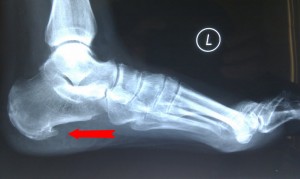Heel Pain
One of the most common presenting problems we see at Rockingham Podiatry is painful heels. There are several possible causes of the heel pain, but the most common condition seen is inflammation of the plantar fascia on the bottom of the foot, which is known as plantar fasciitis.
Middle aged people, over weight people and people who are physically active are the most likely to suffer from heel pain. As children become more active with sport, they may also suffer from heel pain.
Symptoms
Pain may start as a slight bruised feeling. Often there is pain on first rising out of bed, pain after sitting for a while and then standing, or pain develops as the amount of time spent weight bearing continues, eg. walking and standing at work. There may also be pain after sport or exercise. Pain can radiate up into the calf and along the arch of the foot.
The Plantar Fascia
The plantar fascia is a thick, fibrous band of tissue which attaches to the calcaneus (heel bone) at one end and then fans the length of the foot attaching to the metatarsal heads which are towards the toes. It helps to form the arch of the foot and is important in normal foot mechanics during gait. The plantar fascia elongates with weight bearing in walking and then tightens again during propulsion in gait.
Excess stress on the plantar fascia may cause small tears in the tissue which causes pain and inflammation. A spur of bone may grow on the heel bone due to the traction. Without removing the causative factors a chronic inflammatory condition develops.
Treatment
Short term relief can be achieved by addressing the inflammation. For a permanent lasting solution the underlying cause of the excess traction on the plantar fascia must be resolved.
This may include advising of suitable footwear, the prescription and fitting of the right type of orthotic device and a stretching program.
The Role of the Podiatrist
It is important to address the underlying reason for the stress and strain on the plantar fascia. Faulty biomechanics need to be addressed. Suitable footwear is essential.
Calf stretches are also very helpful. Temporary padding of footwear as well as taping of the feet can be useful. In shoe insoles are good at changing faulty mechanics. The podiatrist`s at Rockingham Podiatry can prescribe custom orthotic devices if required, which are very good at dealing with the underlying cause of the complaint and endeavour to prevent future episodes.
Treatment
Addressing the painful inflammatory condition is important. Ice, rest, anti-inflammatory medication and ultrasound are all possible treatment options. As mentioned calf stretches are also helpful. The main form of treatment is to address the underlying problem. This is where correct footwear and in shoe orthoses have their main role. At Rockingham Podiatry we look at the patient, their activity and their gait mechanics to tailor the correct treatment plan for each person.
Book Online or phone 9592 1068 to make an appointment and finally get relief for your painful heel.
